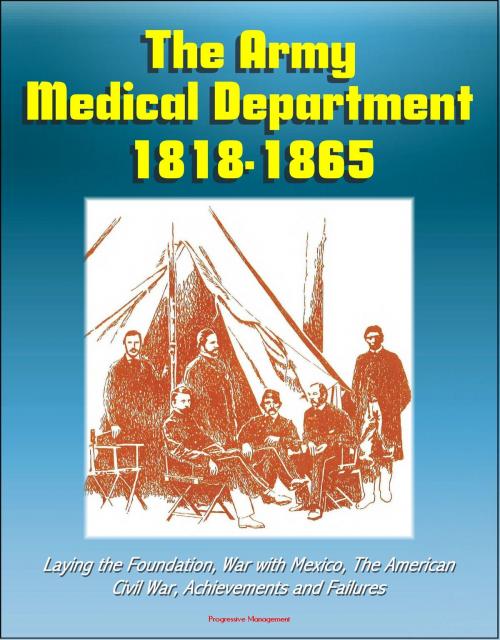The Army Medical Department 1818: 1865, Laying the Foundation, War with Mexico, The American Civil War, Achievements and Failures
Nonfiction, History, Americas, United States, Civil War Period (1850-1877), Military| Author: | Progressive Management | ISBN: | 9781301630806 |
| Publisher: | Progressive Management | Publication: | September 18, 2012 |
| Imprint: | Smashwords Edition | Language: | English |
| Author: | Progressive Management |
| ISBN: | 9781301630806 |
| Publisher: | Progressive Management |
| Publication: | September 18, 2012 |
| Imprint: | Smashwords Edition |
| Language: | English |
This Army military history volume traces the development of the Medical Department from its establishment on a permanent basis in 1818 through the final days of the Civil War in 1865. The uninterrupted existence of the Medical Department after 1818 made possible the gradual transformation of its staff from a collection of physicians of varying skills and attitudes into a group of highly trained and disciplined medical officers, proud of their organization and of their roles in it. Although the state of the art of medicine before 1865 gave the military surgeon few effective weapons against illness and infection, after 1818, the length of the military career of the average medical officer and his professional attitude toward the challenges he met led him to concentrate his efforts on the Army's health problems and to work persistently to improvise ways in which to meet them. The Army Medical Department, 1818-1865 is a significant and long-needed contribution to the history of military medicine.
Contents: 1. THE STATE OF THE ART * Medicine * Surgery * Medical Education * Conclusion * 2. LAYING THE FOUNDATION, 1818-1835 * Organization and Administration * Surgeons in the Field * The Black Hawk War * Conclusion * 3. INDIAN REMOVAL IN THE SOUTHEAST: THE SECOND SEMINOLE WAR * New Leadership for the Medical Department * Removal of the Creeks * Character of the Second Seminole War * Assignment of Surgeons * Supply * General Hospitals * Care of the Sick and Wounded at a Temporary Fort * An Army Surgeon in the Field * Conclusion * 4. LAWSON'S FIRST YEARS AS SURGEON GENERAL, 1836-1845 * Administration in Washington * Problems of Surgeons in the Field * Conclusion * 5. THE WAR WITH MEXICO: THE TAYLOR AND KEARNY CAMPAIGNS. * Administration of the Medical Department * Surgeons in the Field * Conclusion * 6. THE WAR WITH MEXICO: SCOTT'S CAMPAIGN * Preparing for Invasion * Establishing a Base: Vera Cruz * The Drive on Mexico City * After the Victory * Conclusion * 7. LAWSON'S LAST YEARS, 1846-1861 * Administration * The Work of the Army Surgeon as a Physician * Surgeons as Soldiers and Scientists * Conclusion * 8. THE CIVIL WAR, 1861: MANY PROBLEMS, FEW SOLUTIONS * Administrative Problems of the Medical Department * Care of the Sick and Wounded in the East * Care of the Sick and Wounded in the West * Conclusion * 9. THE CIVIL WAR IN 1862: LEARNING ON THE JOB * Care of the Sick and Wounded in the East * Care of the Sick and Wounded in the West * Conclusion * 10. THE CIVIL WAR IN 1863: HAMMOND'S LAST YEAR * Administration of the Medical Department * Care of the Sick and Wounded in the East * Care of the Sick and Wounded in the West * Conclusion * 11. THE CIVIL WAR IN 1864: THE BEGINNING OF THE END * Hammond's Trial * Barnes' Administration * Medical Care of Forces in Virginia * Sherman's Campaign in Georgia * Trans-Mississippi Campaign * Conclusion * 12. THE END * Administration * Grant's Campaign in Northern Virginia * Sherman's Campaign * Prisoners of War * Conclusion * 13. ACHIEVEMENTS AND FAILURES DURING THE CIVIL WAR * Disease * Infection and Wounds * Organization and Administration * Epilogue * BIBLIOGRAPHY
The years between 1818 and the start of the Civil War were in many ways the darkest in the history of medicine in the United States. Doubts as to the validity of time-honored medical practices were growing. Licensing requirements fell victim to egalitarianism, and medical education became a profit-making venture. In any army, disease still caused more deaths than wounds, even during wartime. A few significant new developments, however, stood in stark contrast to the generally stagnant state of the art. and disillusionment with old ways was already beginning to stimulate a search for more scientific methods. Before the start of the Civil War in 1861, an increasing awareness of the need for research and critical observation was emphasizing the Army Medical Department's potential for major contributions to medical science.
This Army military history volume traces the development of the Medical Department from its establishment on a permanent basis in 1818 through the final days of the Civil War in 1865. The uninterrupted existence of the Medical Department after 1818 made possible the gradual transformation of its staff from a collection of physicians of varying skills and attitudes into a group of highly trained and disciplined medical officers, proud of their organization and of their roles in it. Although the state of the art of medicine before 1865 gave the military surgeon few effective weapons against illness and infection, after 1818, the length of the military career of the average medical officer and his professional attitude toward the challenges he met led him to concentrate his efforts on the Army's health problems and to work persistently to improvise ways in which to meet them. The Army Medical Department, 1818-1865 is a significant and long-needed contribution to the history of military medicine.
Contents: 1. THE STATE OF THE ART * Medicine * Surgery * Medical Education * Conclusion * 2. LAYING THE FOUNDATION, 1818-1835 * Organization and Administration * Surgeons in the Field * The Black Hawk War * Conclusion * 3. INDIAN REMOVAL IN THE SOUTHEAST: THE SECOND SEMINOLE WAR * New Leadership for the Medical Department * Removal of the Creeks * Character of the Second Seminole War * Assignment of Surgeons * Supply * General Hospitals * Care of the Sick and Wounded at a Temporary Fort * An Army Surgeon in the Field * Conclusion * 4. LAWSON'S FIRST YEARS AS SURGEON GENERAL, 1836-1845 * Administration in Washington * Problems of Surgeons in the Field * Conclusion * 5. THE WAR WITH MEXICO: THE TAYLOR AND KEARNY CAMPAIGNS. * Administration of the Medical Department * Surgeons in the Field * Conclusion * 6. THE WAR WITH MEXICO: SCOTT'S CAMPAIGN * Preparing for Invasion * Establishing a Base: Vera Cruz * The Drive on Mexico City * After the Victory * Conclusion * 7. LAWSON'S LAST YEARS, 1846-1861 * Administration * The Work of the Army Surgeon as a Physician * Surgeons as Soldiers and Scientists * Conclusion * 8. THE CIVIL WAR, 1861: MANY PROBLEMS, FEW SOLUTIONS * Administrative Problems of the Medical Department * Care of the Sick and Wounded in the East * Care of the Sick and Wounded in the West * Conclusion * 9. THE CIVIL WAR IN 1862: LEARNING ON THE JOB * Care of the Sick and Wounded in the East * Care of the Sick and Wounded in the West * Conclusion * 10. THE CIVIL WAR IN 1863: HAMMOND'S LAST YEAR * Administration of the Medical Department * Care of the Sick and Wounded in the East * Care of the Sick and Wounded in the West * Conclusion * 11. THE CIVIL WAR IN 1864: THE BEGINNING OF THE END * Hammond's Trial * Barnes' Administration * Medical Care of Forces in Virginia * Sherman's Campaign in Georgia * Trans-Mississippi Campaign * Conclusion * 12. THE END * Administration * Grant's Campaign in Northern Virginia * Sherman's Campaign * Prisoners of War * Conclusion * 13. ACHIEVEMENTS AND FAILURES DURING THE CIVIL WAR * Disease * Infection and Wounds * Organization and Administration * Epilogue * BIBLIOGRAPHY
The years between 1818 and the start of the Civil War were in many ways the darkest in the history of medicine in the United States. Doubts as to the validity of time-honored medical practices were growing. Licensing requirements fell victim to egalitarianism, and medical education became a profit-making venture. In any army, disease still caused more deaths than wounds, even during wartime. A few significant new developments, however, stood in stark contrast to the generally stagnant state of the art. and disillusionment with old ways was already beginning to stimulate a search for more scientific methods. Before the start of the Civil War in 1861, an increasing awareness of the need for research and critical observation was emphasizing the Army Medical Department's potential for major contributions to medical science.















